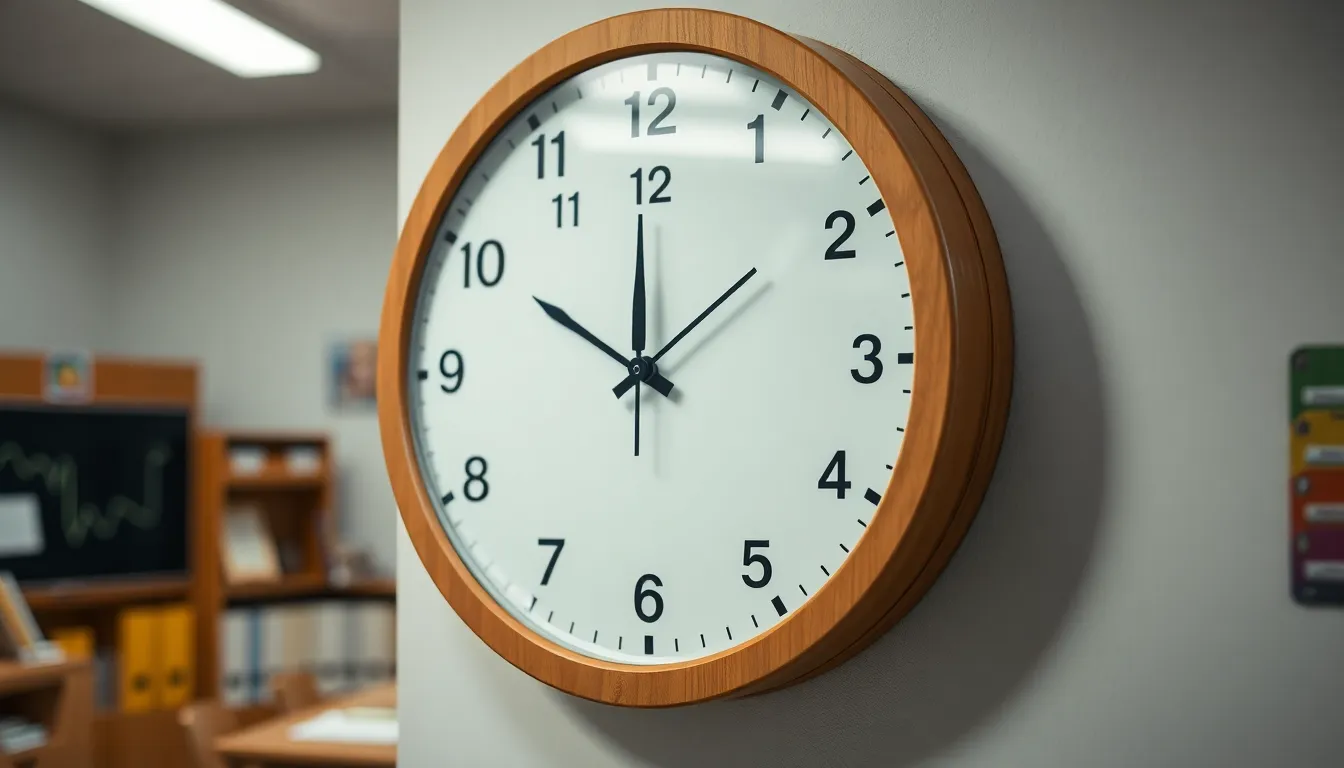Time’s a tricky little devil, isn’t it? One minute you’re sipping coffee, and the next, you’re racing against the clock wondering how many minutes are left until 3:15. If you’ve ever found yourself in a time crunch, you’re not alone. It’s a universal struggle that can turn even the calmest person into a frazzled mess.
Table of Contents
ToggleUnderstanding Time Calculation
Understanding how to calculate time helps manage schedules and reduce anxiety. Knowing exact minutes until a specific time, like 3:15, can streamline planning and enhance productivity.
Importance of Time Awareness
Time awareness plays a critical role in daily life. Being conscious of the time helps in meeting appointments and deadlines. Effective time management improves overall efficiency and reduces stress. Individuals who track their time can allocate tasks appropriately and prioritize responsibilities. Enhanced awareness fosters punctuality and promotes better decision-making.
Different Methods of Time Calculation
Several methods exist for calculating time. Mental math can quickly determine minutes until a target time. Using a clock, one can visually assess the time difference. Digital tools, such as countdown timers or mobile apps, simplify tracking time. Each method varies in complexity and accuracy, allowing individuals to choose based on their needs. Understanding these methods enhances time management skills, preventing last-minute rushes.
Simple Time Calculation

Understanding how to calculate time effectively helps individuals manage their schedules. Knowing how many minutes until 3:15 proves useful in various scenarios, like setting reminders or planning tasks.
Using Basic Addition
Basic addition simplifies time calculations. When calculating minutes until 3:15, one can determine the current hour and minute. For example, if it’s 2:30, adding 45 minutes provides the answer. Recognizing that 30 minutes completes the hour, one can add another 15 minutes to reach 3:15. This approach illustrates that mental math enhances time awareness and reduces the likelihood of lateness.
Using Subtraction Techniques
Subtraction techniques also facilitate time calculations. To find out how many minutes remain until 3:15, start with the current time. If it’s 3:00, subtract 3:00 from 3:15. This results in a difference of 15 minutes. For a current time of 2:50, the subtraction process involves determining the difference between 2:50 and 3:15. This results in 25 minutes. Utilizing subtraction provides clarity in determining exact time intervals.
Real-Life Applications
Understanding time management enhances personal efficiency and reduces feelings of anxiety. Effective time calculation can help individuals allocate their minutes wisely throughout the day.
Time Management Skills
Improved time calculation leads to better time management skills. Recognizing how many minutes remain until specific times, like 3:15, helps people prioritize tasks. Acquiring these skills promotes a smoother workflow, allowing individuals to focus on achieving their goals. Practicing mental math or using tools can simplify day-to-day scheduling. By mastering these techniques, individuals navigate busy schedules with confidence and clarity.
Importance in Scheduling
Accurate time estimation plays a crucial role in scheduling. Knowing exactly how many minutes until a target, such as 3:15, helps in setting appointments effectively. This awareness prevents overlaps and creates opportunities for timely completion of tasks. The ability to assess time helps individuals respect others’ schedules and manage their commitments efficiently. As deadlines approach, being aware of time remaining increases accountability and reduces last-minute scrambles.
Common Mistakes in Calculating Time
Calculating time accurately is essential for effective time management. Several common mistakes can arise during this process.
Misunderstanding the Clock
Using analog clocks can lead to confusion. Individuals might misread the hour hand and minute hand, resulting in incorrect time assessments. One common error involves misinterpreting the position of the hands, especially during transitions between AM and PM. Misjudgment of clockwise and counter-clockwise directions may also contribute to inaccuracies. Familiarity with the clock layout aids in quick, precise calculations. Moreover, practicing reading various clock styles enhances overall time comprehension.
Miscalculating AM and PM
Confusion often arises when distinguishing between AM and PM. A mix-up can lead to arriving early or late for appointments. For example, interpreting 2:30 PM as 2:30 AM can throw schedules off balance. Awareness of one’s morning and evening routines can help mitigate these errors. Recognizing common scenarios like meetings and deadlines improves time management. Utilizing digital devices with clear AM/PM indicators reduces the likelihood of mistakes. Actively checking the specified part of the day before making plans ensures accuracy.
Mastering time calculation is essential for managing schedules effectively. By understanding how many minutes remain until a specific time like 3:15 individuals can reduce anxiety and enhance their efficiency. Utilizing techniques such as mental math and digital tools empowers them to navigate busy days with confidence.
Being aware of common mistakes when reading clocks can further improve accuracy in time management. With practice and the right strategies, anyone can transform their approach to time, leading to a more organized and less stressful life. Embracing these skills not only promotes personal accountability but also fosters respect for others’ time, creating a smoother workflow for everyone involved.




